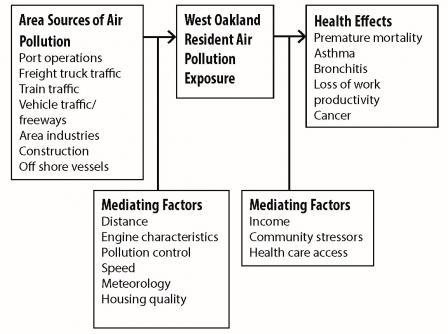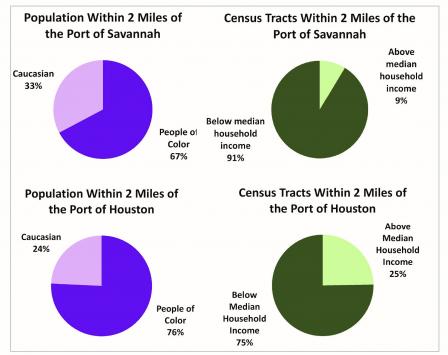Environmental Justice Primer for Ports: Impacts of Port Operations and Goods Movement
With each plan, project or program, port agencies have an opportunity to promote environmental justice and equitable development by seeking ways to reduce impacts and increase benefits to near-ports communities. This section describes common health and quality-of-life impacts on near-port communities that ports agencies can begin to remedy through more equitable decision-making over time.
On this page:
- Port-related pollutants and health hazards
- Cumulative impacts on quality of life
- Inequitable distribution of benefits and burdens
Port-related pollutants and health hazards
Common Ports-Related Community Interests
- Public safety
- Competing land uses
- Impacts from nuisances
- Environmental justice
- Resilient adaptation
- Post-Panamax shipping
- Jobs and job training programs
- Labor and working conditions
- Impacts on goods movement
- Air emissions
- Water pollution
- Public health impacts
- Ecological impacts
- Access to natural areas, including waterfronts and open space
Near-port communities and tribes can face challenges due to sustained exposure to pollutants and toxins, and health impacts from this exposure can span across multiple generations.
Air pollution
The emissions from goods movement through trucks, marine vessels, trains, cargo handling equipment as well as from stationary sources such as refineries, oil and gas storage facilities, power generation and storage of open coal piles found near port facilities can introduce many air pollutants with the potential to severely impact the health of near-port communities. Exposure to air pollution associated with emissions from diesel engines can contribute to significant health problems—including premature mortality, increased hospital admissions for heart and lung disease, increased cancer risk, and increased respiratory symptoms—especially for children, the elderly, outdoor workers and other sensitive populations.14
Water pollution
Port operations can have a significant impact on neighborhood water quality. Runoff from impervious surfaces can carry pollutants that may prevent people from enjoying local creeks, lakes or bays, and from eating fish and shellfish from these waters. In some cases, community members may rely on fishing as a subsistence source of food.
Light and noise pollution
Health impacts of light and noise pollution from port operations can include hearing impairment, high blood pressure and sleep deprivation.15
Cumulative impacts on quality of life
Environmental justice communities often experience stressors beyond health disparities such as neighborhood disinvestment, income inequality, public safety concerns around truck routes and rail crossings, and coastal-related threats from extreme weather events and climate change. In addition, the industrial super blocks, rail lines and highways surrounding ports can create barriers between residents and basic necessities such as grocery stores, health services, pharmacies, retail centers, transit and recreation spaces. Industrial features in near-port areas mean that near-port neighborhoods often lack adequate sidewalks, street trees, safe intersection crossings and other basic infrastructure.
Inequitable distribution of benefits and burdens
 Figure 3: Air pollution. Figure 3 illustrates how stressors from air pollution and socio-economic factors can create cumulative impacts on near-port communities. Source: Health Impact Assessment for Port of Oakland (University of California, Berkeley)The disproportionate impacts that may be experienced by these communities can be compounded when they do not receive the same level of benefits from port activities – such as jobs and economic growth – that are enjoyed regionally. Figure 3 shows how stressors from air pollution and socio-economic factors create cumulative impacts on near-port communities.
Figure 3: Air pollution. Figure 3 illustrates how stressors from air pollution and socio-economic factors can create cumulative impacts on near-port communities. Source: Health Impact Assessment for Port of Oakland (University of California, Berkeley)The disproportionate impacts that may be experienced by these communities can be compounded when they do not receive the same level of benefits from port activities – such as jobs and economic growth – that are enjoyed regionally. Figure 3 shows how stressors from air pollution and socio-economic factors create cumulative impacts on near-port communities.The disparities in environmental burdens and economic benefits disproportionately affect low-income communities and communities of color and can also be exacerbated by long-term disinvestment and challenging socioeconomic conditions. For example, Figure 4 shows that residents of near-port communities in Savannah, Georgia, and Houston, Texas, are predominately people of color and predominantly have below median household incomes. These communities often lack access to the time, resources, technical knowledge and political capital needed to address issues of concern.
 Figure 4: Near-port communities are most often low income communities of color and suffer disproportionate impacts from port operations. These charts demonstrate the demographics of the communities within 2 miles of the Port of Houston and the Port of Savannah. (Source: EPA, Ports Primer for Communities, Section 4.1)It can be helpful for ports and port-related industries to maintain a focus on general disproportionality and equity objectives as it can be difficult to isolate the impacts of one source from another (e.g., air quality impacts from idling ships versus air quality impacts from surrounding transportation infrastructure). The impacts from these various sources can be disproportionately high in these communities. This strategy can help ports and near-port communities quickly begin meaningful engagement by acknowledging the disproportionate impacts and focusing on how they can provide solutions within their control and influence.
Figure 4: Near-port communities are most often low income communities of color and suffer disproportionate impacts from port operations. These charts demonstrate the demographics of the communities within 2 miles of the Port of Houston and the Port of Savannah. (Source: EPA, Ports Primer for Communities, Section 4.1)It can be helpful for ports and port-related industries to maintain a focus on general disproportionality and equity objectives as it can be difficult to isolate the impacts of one source from another (e.g., air quality impacts from idling ships versus air quality impacts from surrounding transportation infrastructure). The impacts from these various sources can be disproportionately high in these communities. This strategy can help ports and near-port communities quickly begin meaningful engagement by acknowledging the disproportionate impacts and focusing on how they can provide solutions within their control and influence.